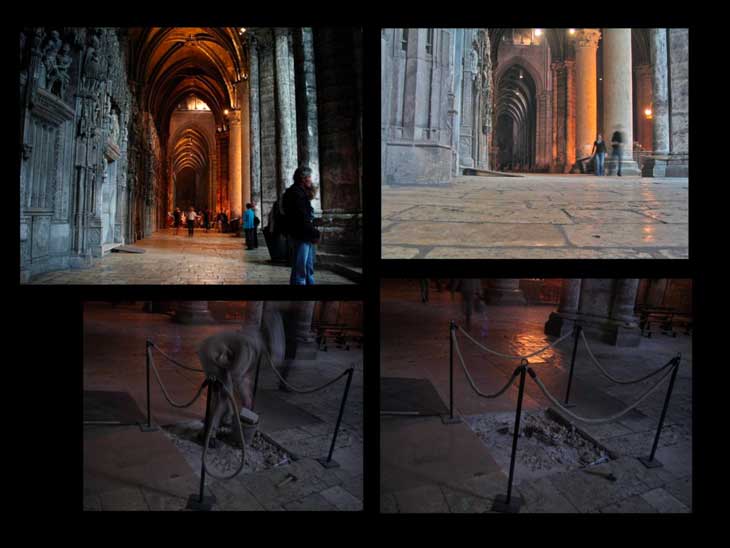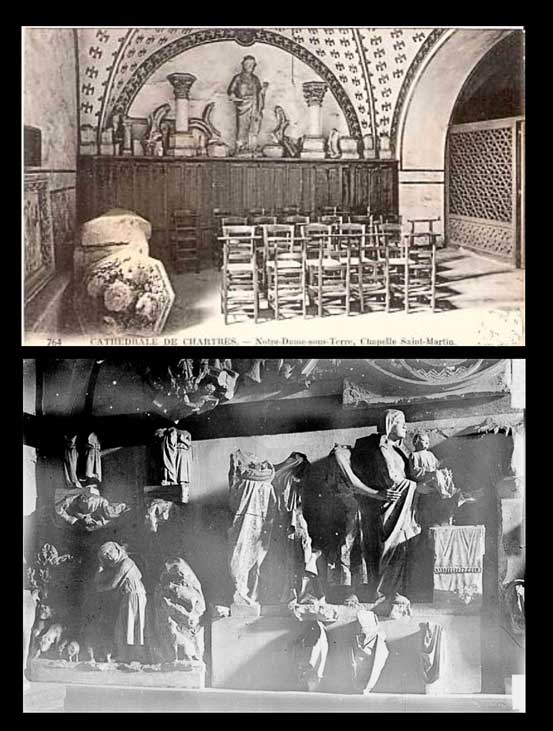During the restoration of the choir & high choir between 2009 and 2011, a printed tarpaulin had been installed in front of the choir, allowing to imagine what was the former rood screen of the cathedral.
Here are all the keys to understand the history of the rood screen – with some little known pictures…
About the rood screen of the cathedral
What became of the debris of the rood screen?
At first, it is likely that the people of Chartres were able to help themselves to the rubble and thus make up for the repairs to their homes. Then the master builders, in accordance with the ancient provisions of canon law which assign to the remains of a religious building the obligation to be used in situ – in consecrated ground – used the bas-reliefs for the repairs of the pavement, face down: at the crossing of the transept, then near the side gates of the choir. A shocking solution, but one that preserves the future.
In 1836, following a fire in the attic, blocks of molten lead had fallen onto the paving and required the intervention of the masons. A lawyer from Chartres (Doublet de Boisthibaut) informed the authorities of the discovery of several sculptures.
In 1848-49, the architect Lassus undertook systematic excavations, which quickly proved to be fruitful. It soon became apparent that some fragments still had their original polychromy.
The most remarkable sculptures were presented in the crypt, then in the Saint-Piat chapel, between 1969 and 1993. Although some pieces are the property of the Metropolitan Museum, the Louvre Museum or private collectors, 95% of the known elements are present in Chartres: currently invisible to the public, while waiting to be installed in the chapter house, with a presentation that will borrow from the most innovative museography in a project for the reorganization of the treasure (on the first floor of the Saint-Piat chapel, as well as of the lapidary on the first floor), rendered by the architect P. Calvel and approved by the Direction Régionale des Affaires Culturelles.
What does the inventory of the existing fragments give?
We find – in particular – two large ornate quatrefoils, one with the figures of the evangelists, the other with earthly animals, and seven large reliefs of the childhood of Christ: Annunciation, Nativity, Announcement to the shepherds, Magi and Herod, Adoration of the Magi, Awakening of the Magi, Presentation in the Temple.
Everything is there: artists who are notoriously inspired, scenes rich in symbols, pages that are among the most beautiful of the Gospel, an obvious talent in the rendering of gestures and the expression of faces, a quality of execution and a sense of detail that defies understanding, a state of conservation that has few equals – since these sculptures have obviously not suffered the effects of weather. Experts rank the reliefs among the most beautiful sculptures left to us by the Middle Ages. One remembers the great Anglo-Saxon scholars who approached them with childlike excitement and wide eyes.
What was the rood screen like?
This can be deduced both from several engravings dating from the 17th / 18th century and from ‘archaeological’ discoveries made in the 19th century.
It was a covered gallery, vaulted with ogives and resting on columns of extreme finesse.
On the choir side, there were two staircases allowing access to the platform.
On the nave side, the rood screen had the appearance of a cloister, with seven arcades – each of them composed of a double opening, a rose and surmounted by a gable.
Between the gables, at the level of the parapet, were reliefs of the infancy of Christ: that is to say that the meditation on the coming of Christ in the history of men was – really – at the center of the cathedral.







